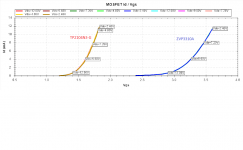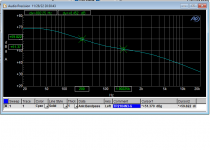Here's one chart of Id vs Vgs for both devices. The TP2104N3-G has a lower Vgs(th) and higher gmMicrochip's TP2104N3-G is a P-Channel MOFET with protection diode in T0-92 package. I ordered some to compare in my Pearl II. If a part is out of stock, going to: https://www.findchips.com/search/zvp3310 may help.
Attachments
Today is Wayne's birthday.
Happy Birthday Wayne!

Happy Birthday Wayne!

All the best, Wayne!
Thanks for beautiful projects offered to us greedy boys...
Cheers
Dirk
🙂
Thanks for beautiful projects offered to us greedy boys...
Cheers
Dirk
🙂
Pass DIY Addict
Joined 2000
Paid Member
I always seem to be late to the party, but it doesn't diminish the sincerity of my birthday well-wishes. Happy Birthday, Wayne!
After a few years of excellent listening my Pearl II has developed a pop on startup in the left channel. Otherwise, it's still fine. Any thoughts before I start meddling?
First guess, without diagnosis, would be zvt3310. They seem to be very prone to static damage. But if happening on both channels the problem is likely in the PSU section.
To test if it’s the ZVP, see if the potentiometer properly adjusts DC balance at the test point near R17.
If pot behaves as you expect, it’s good. If not, it needs replacing.
If pot behaves as you expect, it’s good. If not, it needs replacing.
Readjust P1 for "0" at the test point.After a few years of excellent listening my Pearl II has developed a pop on startup in the left channel. Otherwise, it's still fine. Any thoughts before I start meddling?
Does it "pop" every time afterward? It may be that one or more of the electrolytic capacitors has not fully discharged, that the poz and neg rails are charging up at different rates, or that there is a fault with C13. In any event, at turn-on, a charge will move across C13 if there is a voltage differential at the junction of R16 and R17.
You could also decrease the value of R18 from 100k to discharge C13 more quickly.
Helpful if you have a scope
Thanks for the suggestions. So far I have replaced the ZVP to no avail... still pops in the left channel on startup, whether after a lengthy idle or soon after switch off. Will check the P1 in the next day or so. Unfortunately don't have an oscilloscope.
Unrelated, I changed out the C12 and C16 capacitors for a 0.33 uF K40Y-9 capacitor. While the overall presentation seemed a bit richer, the bass was a bit loose and the top end not as vibrant. After a period of listening I decided it was simply boring. On the basis of a one to 100 ratio for a bypass capacitor that has tightened things up in the past I bypassed the K40s with Russian 5100 pF silver micas and am delighted. Everything sounds better. The cadence and timbre shows up wonderfully with strings, and orchestral, rock and jazz are all far better. I have no idea how it all measures but I am very happy!
Unrelated, I changed out the C12 and C16 capacitors for a 0.33 uF K40Y-9 capacitor. While the overall presentation seemed a bit richer, the bass was a bit loose and the top end not as vibrant. After a period of listening I decided it was simply boring. On the basis of a one to 100 ratio for a bypass capacitor that has tightened things up in the past I bypassed the K40s with Russian 5100 pF silver micas and am delighted. Everything sounds better. The cadence and timbre shows up wonderfully with strings, and orchestral, rock and jazz are all far better. I have no idea how it all measures but I am very happy!
To update: Sound deteriorated somewhat so checked voltages which were down around Q3 (ZTX450) so replaced without success. Replaced Q1 and voltages then comparable with other channel -- around 7v. This is still lower than the 10v in the schematic but comparable with those observed sometime ago by another poster.
Have reduced the silver mica bypass capacitor to 3000 pF. They take a while to break in and show their true colours. 3300 pF should be ideal.
Have reduced the silver mica bypass capacitor to 3000 pF. They take a while to break in and show their true colours. 3300 pF should be ideal.
- Home
- Amplifiers
- Pass Labs
- Pearl Two

